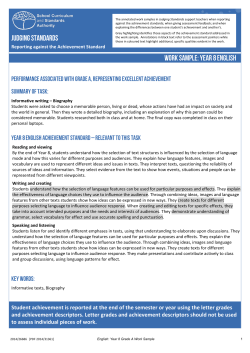
Unit I accomplishes four key goals. First, students learn how... in order to determine the core themes or central ideas...
Grade 11--Quarter I--Unit I: Writing About Narrative Literature Big Picture Unit I accomplishes four key goals. First, students learn how to deconstruct complex narrative texts in order to determine the core themes or central ideas that unify the work, and they read closely to figure out how the writer shaped or developed the themes (RL.1.2). Second, students analyze how certain choices an author makes culminate to certain effects (RL.1.3). Third, students learn how to explain their analyses in writing (W.1.2) and draw evidence from text to support their findings (W.3.9). Finally, students move beyond writing about narrative literature and turn to writing their own narrative piece (W.1.3). In the Language Arts Florida Standards there is a clear distinction between what a 9th or 10th grader can do with the theme of a text and what an 11th or 12th grader can do. LAFS.1112.RL.1.2 specifically calls for analysis of a complex work that has more than one theme; therefore, scaffolding towards the complex account may be necessary in the early part of Unit I. Studying a work that only has one plausible theme is a logical starting point, but it is impossible to achieve the full intent of the standard without moving to a more complex work. Standards Reading RL.1.2 Supporting: RL.1.3 Writing W.1.3 Supporting: W.1.2 Language L.3.4 Speaking & Listening SL.2.4 Recursive RL.1.1, L.1.1, 1.2, W.3.9a Student Skills: 1. 2. 3. 4. 5. 6. Arrive at an analysis of content through close reading (RL1.1). Determine multiple themes or central ideas within a work (RL.1.2). Connect an author’s choice of literary elements to the how they impacts readers (RL.1.3). Provide an effective objective summary of the text, not just a retelling of the plot (RL.1.2) (W.1.2). Verbally express ideas about a text; support the ideas using the text itself and logical thought (SL.2.4). Explain analysis and learn to quote accurately from the text in both informal and formal writing (W.1.2, 3.9). Teacher Skills: 1. Shape engaging text-dependent tasks that are aligned to the standards and inspire close reading. 2. Model how close reading and annotation are used to achieve set purpose. 3. Gradually release students into the process of analyzing a text and backing up their analysis with logical thought and strong evidence from the text. Selecting Texts The 2014-2015 Curriculum Blueprint offer recommended literary texts. In replacing these texts, teachers will uphold the new national, state, and district expectations for teaching of complex text. As modeled in the Blueprint, text-selection incorporates not only Lexile scores but also qualitative measures of difficulty, and Reader/Task considerations. Note: It is impossible to explore complexities within themes and story elements if the work itself is not complex; therefore, texts with entirely obvious themes or simplistic devices would be poor selections.
© Copyright 2025





















